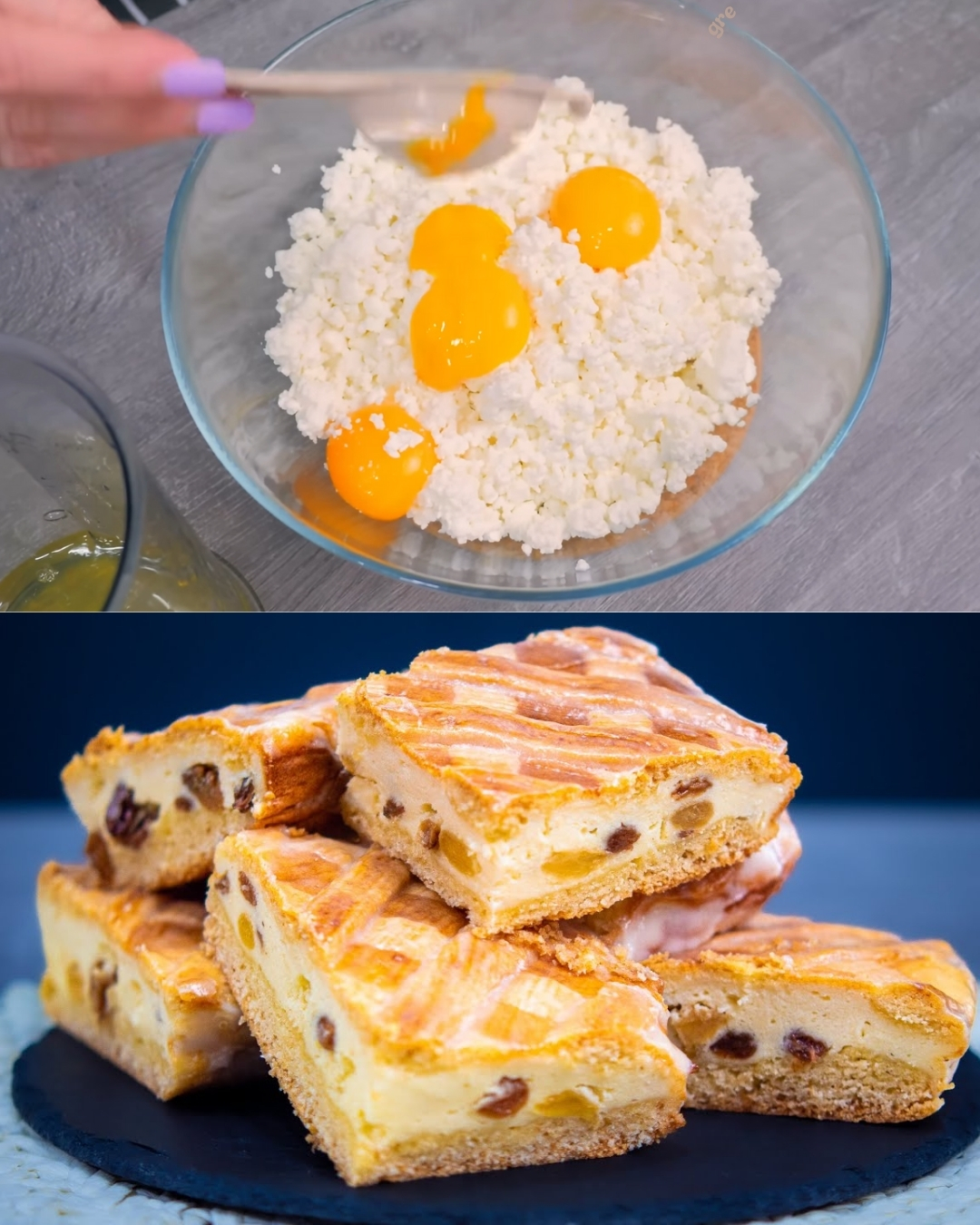Rich, comforting, and delightfully old-fashioned, this Cottage Cheese and Raisin Tart with Sour Cream Glaze is a recipe passed down through generations, often found at family tables across Central and Eastern Europe. With a tender, buttery crust, a creamy cottage cheese filling, and a silky sour cream glaze, it brings a balance of sweet, tangy, and subtle textures. Perfect for tea time, Sunday brunch, or holiday gatherings, this tart satisfies without overwhelming. It’s a nostalgic dessert that feels like home in every bite.
Cooking Time
-
Preparation Time: 25 minutes
-
Baking Time: 50 minutes
-
Cooling Time: 1 hour
-
Total Time: 2 hours 15 minutes
-
Servings: 10 slices
Ingredients
For the Dough:
-
300 g (1.5 cups) wheat flour
-
60 g sugar
-
1.5 tsp (8 g) baking powder
-
1 pinch salt
-
150 g cold butter, cubed
-
1 egg (55 g without shell)
-
50 g (1 tbsp) sour cream
For the Filling:
-
120 g raisins
-
500 g cottage cheese (any fat content)
-
3 eggs (yolks and whites separated)
-
120 g sugar (6 tbsp without slide)
-
60 ml milk
-
60 g corn starch (2 heaping tbsp)
-
1 pinch salt
-
10 g vanilla sugar (1 packet)
For the Glaze:
-
80 g icing sugar (4 tbsp)
-
100 g sour cream (2 tbsp)
Step-by-Step Cooking Directions
1. Make the Dough
-
In a large bowl, mix flour, sugar, baking powder, and salt.
-
Add cold butter cubes and rub them into the dry ingredients using your fingertips until the texture resembles coarse crumbs.
-
Add egg and sour cream. Mix until a soft dough forms.
-
Press into a disk, wrap in plastic, and refrigerate for 30 minutes.
2. Prepare the Filling
-
Rinse the raisins and soak them in warm water for 10 minutes. Drain and pat dry.
-
In a large bowl, mash the cottage cheese with a fork or blend briefly for a smoother texture.
-
Add the egg yolks, sugar, milk, corn starch, salt, and vanilla sugar. Mix well.
-
Whip the egg whites until soft peaks form. Gently fold them into the cheese mixture.
-
Add the drained raisins and gently fold again until fully incorporated.
3. Assemble the Tart
-
Preheat oven to 170°C (340°F), top and bottom heat.
-
Roll out the chilled dough on a lightly floured surface to fit a tart pan (about 10–11 inches or 26–28 cm diameter).
-
Gently press the dough into the pan, trimming any overhang.
-
Pour in the filling and smooth the top with a spatula.
4. Bake
-
Bake in the preheated oven for 50 minutes.
-
The top should be golden and the filling set in the center.
-
Remove and let cool completely in the pan on a wire rack.
5. Glaze the Tart
-
Mix icing sugar and sour cream until smooth.
-
Spread the glaze evenly over the cooled tart.
-
Chill for at least 30 minutes before slicing and serving.
Nutritional Information (Per Slice, Approximate)
-
Calories: 320
-
Carbohydrates: 32g
-
Protein: 10g
-
Fat: 18g
-
Saturated Fat: 10g
-
Fiber: 1g
-
Sugar: 20g
-
Sodium: 160mg
Origins and Popularity of the Recipe
This kind of cottage cheese tart has roots in Eastern European and Russian cuisine, where dairy and pastry traditions run deep. It reflects the simplicity and richness of rural baking — combining affordable, nourishing ingredients like curd cheese and flour. Over time, this humble dessert became a beloved part of festive tables and Sunday family meals. Today, it’s popular globally among those who appreciate old-world baking with modern ease.
Reasons Why You’ll Love This Recipe
-
Comforting flavors: Creamy, tangy, and lightly sweet — a true nostalgic treat.
-
Versatile: Serve it for breakfast, dessert, or even as a brunch centerpiece.
-
Make-ahead friendly: Tastes even better chilled the next day.
-
Balanced texture: Crisp crust, fluffy filling, smooth glaze — all in one bite.
Health Benefits
-
Cottage cheese: High in protein and calcium, supporting bone health.
-
Eggs: Rich in B vitamins and essential nutrients.
-
Raisins: Provide natural sweetness, iron, and antioxidants.
-
Homemade dough: Allows control over sugar and additives compared to store-bought crusts.
Serving Suggestions
-
Dust with powdered sugar just before serving for a bakery finish.
-
Serve chilled or room temperature with hot tea or coffee.
-
Add a few fresh berries or fruit compote on the side for a color and flavor boost.
-
Perfect with a dollop of whipped cream or vanilla yogurt.
Common Mistakes to Avoid
-
Overmixing the dough: Will make the crust tough. Mix just until combined.
-
Wet filling: Be sure to drain the raisins and blend cottage cheese if too watery.
-
Undercooked base: Make sure the crust is golden and firm before removing from the oven.
-
Glazing while hot: Always let the tart cool before adding the glaze to prevent it from melting off.
Pairing Recommendations
-
Beverage: A cup of black tea, chamomile tea, or cappuccino pairs perfectly.
-
Wine: Light dessert wines like Moscato or Riesling complement the mild sweetness.
-
Savory touch: Serve with a few slices of aged cheese for a unique sweet-savory balance.
Cooking Tips
-
Use cold butter: For a flakier crust.
-
Chill the dough: It makes it easier to handle and enhances texture.
-
Whip egg whites separately: This gives the filling its signature fluffiness.
-
Use full-fat sour cream and cottage cheese: For a richer taste and better structure.
Similar Recipes to Try
-
Russian Syrniki (Cheese Pancakes)
-
Polish Sernik (Baked Cheesecake)
-
Hungarian Túrós Rétes (Curd Cheese Strudel)
-
German Käsekuchen (Quark Cheesecake)
-
Farmer’s Cheese Tart with Apricots
Variations to Try
-
With fruit: Add chopped dried apricots, cranberries, or fresh blueberries to the filling.
-
Citrus zest: Add lemon or orange zest to the filling for brightness.
-
Chocolate glaze: Swap the sour cream glaze for a light cocoa icing.
-
Whole wheat flour: For a nuttier and fiber-rich crust.
-
Nut crust: Use crushed almonds or walnuts in the base for added texture.
Ingredient Spotlight: Cottage Cheese
Cottage cheese, also known as curd cheese or farmer’s cheese, is a soft, fresh cheese that’s packed with nutrients. It’s low in fat, high in protein, and contains beneficial probiotics if unpasteurized. Its mild flavor and creamy texture make it ideal for both savory and sweet baking. In this tart, it offers a rich yet light consistency, balancing the sweetness of the raisins and sugar.
Conclusion
This Cottage Cheese and Raisin Tart with Sour Cream Glaze is more than just a dessert — it’s a slice of heritage, comfort, and wholesome indulgence. Whether you’re making it for guests, holidays, or just as a midweek treat, it never fails to deliver that homemade charm. Easy enough for everyday baking yet elegant enough for celebration, this tart deserves a spot in your recipe collection.
10 Comprehensive Frequently Asked Questions
1. Can I use ricotta instead of cottage cheese?
Yes, ricotta can be used, but it has a softer texture and milder taste. Drain it well for best results.
2. What’s the best way to make the crust flakier?
Keep your butter cold and avoid overworking the dough. Chill it before rolling out.
3. Can I reduce the sugar in the filling?
Absolutely. You can cut it by 20–30% if you prefer a less sweet dessert.
4. Can I use Greek yogurt instead of sour cream in the glaze?
Yes, thick Greek yogurt works as a tangy substitute, though it may be less glossy.
5. Can I make this tart gluten-free?
Use a 1:1 gluten-free flour blend and check that your baking powder is GF certified.
6. How long will it last in the fridge?
Store covered in the refrigerator for up to 4 days. Best enjoyed chilled.
Advertisement
7. Can I freeze it?
Yes, wrap it tightly in plastic and foil, and freeze for up to 1 month. Thaw overnight in the fridge.
8. How do I prevent the tart from cracking on top?
Don’t overbake and avoid sudden temperature changes. Cool gradually at room temperature.
9. Can I use a springform pan instead of a tart pan?
Yes, but line the bottom with parchment for easier removal.
10. Is this recipe suitable for kids?
Yes, it’s high in calcium and protein and not overly sweet — a kid-friendly dessert!

